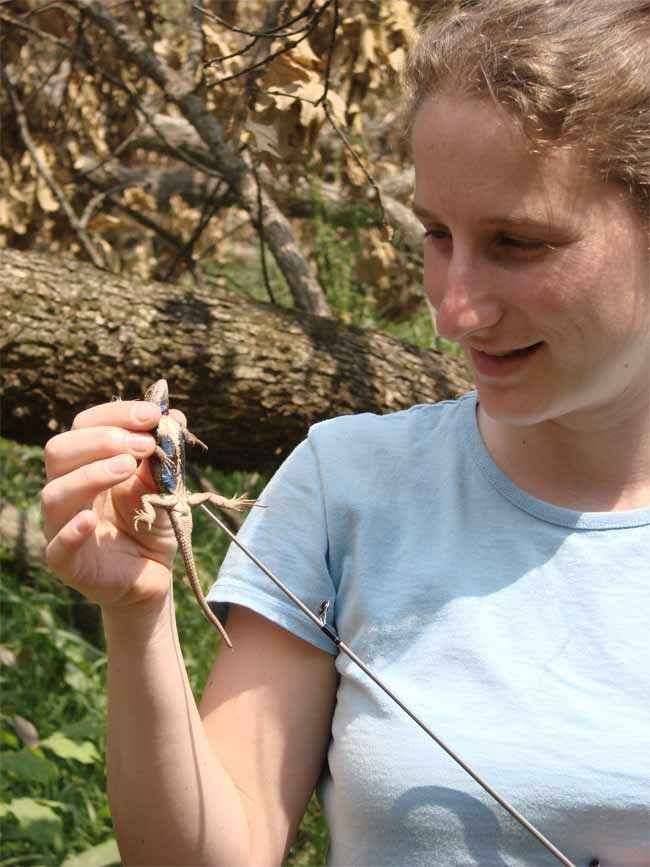Lizards' Dance Avoids Deadly Ants

Some lizards have developed long legs and a dance move that helps them avoid being possibly eaten alive by lethal fire ants.
Fire ants from South America, called Solenopsis invicta, were introduced to the United States accidentally in the 1930s. The pesky creatures are known to attack so-called fence lizards, both those that wander onto ant mounds and even those far away from a mound.
They inject a toxin into their victim and then munch away.
"Fire ants need protein, especially for their developing brood," said Tracy Langkilde, a Penn State biologist. "It takes just 12 of them less than a minute to kill a three-inch-long fence lizard. In fact, they have even been known to eat animals as large as calves, stripping them down to their bones," she said, referring to live calves.
She added, "They can kill calves, and will strip the carcass."
In a new study, to be published this month in the journal Ecology, Langkilde found that some lizards are better than others at escaping the fire ants.
Lizard dance
Sign up for the Live Science daily newsletter now
Get the world’s most fascinating discoveries delivered straight to your inbox.
Langkilde wanted to find out how the lizards responded to such fire-ant attacks. So she collected 20 male and 20 female lizards from each of four sites — one in Arkansas that had not been invaded by fire ants and others in Mississippi and Alabama that were invaded 23, 54 and 68 years ago.
She brought the lizards to a natural fire-ant mound and watched as the lizards ran onto the mound, where the ants crawled around on the lizards' bodies looking for scales to lift up. Typically, once the ants lift a scale covering the skin to expose a lizard's soft flesh, they inject neuromuscular venom into the skin that can paralyze and kill the lizard.
(Langkilde stopped the experiment after a minute to keep the ants from killing the lizards.)
The results showed two lizard responses. Lizards that were unfamiliar with the ants often just sat there and did nothing. But lizards collected at sites that had been invaded by the ants were more proactive in their defense.
"They do this big body shimmy, or a body twitch, where they shake their body to fling the ants off them, and then they run away from the mound," Langkilde told LiveScience.
While 40 percent to 50 percent of the lizards collected from a non-invaded site did the shimmy-and-run maneuver, 80 percent of lizards from the site invaded 68 years ago responded in such a way.
Lizard legs
When she measured the lizards' legs, she found individuals from the site invaded 68 years ago had hind legs that were about 5 percent longer than both the site without fire ants and the site invaded 23 years ago.
The fence lizards with the longer legs could remove more ants with their body shimmies and get away the fastest.
"It's likely that it's just increased leverage, so if you have longer legs then you can do more exaggerated twitches and you can take off really fast, so you're more likely to be able to flick off these ants that are crawling all over you," Langkilde said.
Next, she plans to use high-speed video to record the body twitches and figure out how exactly the longer legs benefit the lizards.
She also wants to figure out whether the body-twitch behavior evolved in lizards or is learned from repeated exposure to the ants.
When she tested juvenile lizards from the different sites, they all responded with the body-twitch behavior. She thinks that's because the babies are tiny with soft scales and so are vulnerable even to native, non-venomous ants.
That could suggest the babies are born with the knowledge. Perhaps some lizards hold onto this baby behavior into adulthood and others don't. The ability to remember the trick could be due to genetics, which would mean it's passed down to future generations. Further research could answer these questions, she said.
- Images: Snakes, Frogs and Lizards
- Lizard News, Information and Images
- Evolution in Action: Lizards Losing Limbs
Jeanna Bryner is managing editor of Scientific American. Previously she was editor in chief of Live Science and, prior to that, an editor at Scholastic's Science World magazine. Bryner has an English degree from Salisbury University, a master's degree in biogeochemistry and environmental sciences from the University of Maryland and a graduate science journalism degree from New York University. She has worked as a biologist in Florida, where she monitored wetlands and did field surveys for endangered species, including the gorgeous Florida Scrub Jay. She also received an ocean sciences journalism fellowship from the Woods Hole Oceanographic Institution. She is a firm believer that science is for everyone and that just about everything can be viewed through the lens of science.

Earth from space: The heart-shaped 'Spirit Lake' sculpted by Mount St. Helens' epic eruption

Hims & Hers Super Bowl controversy: What the ad left out about its 'alternative' weight-loss drugs

Mysterious tunnels sketched by Leonardo da Vinci in 1495 may finally have been discovered — hidden under a castle in Milan
